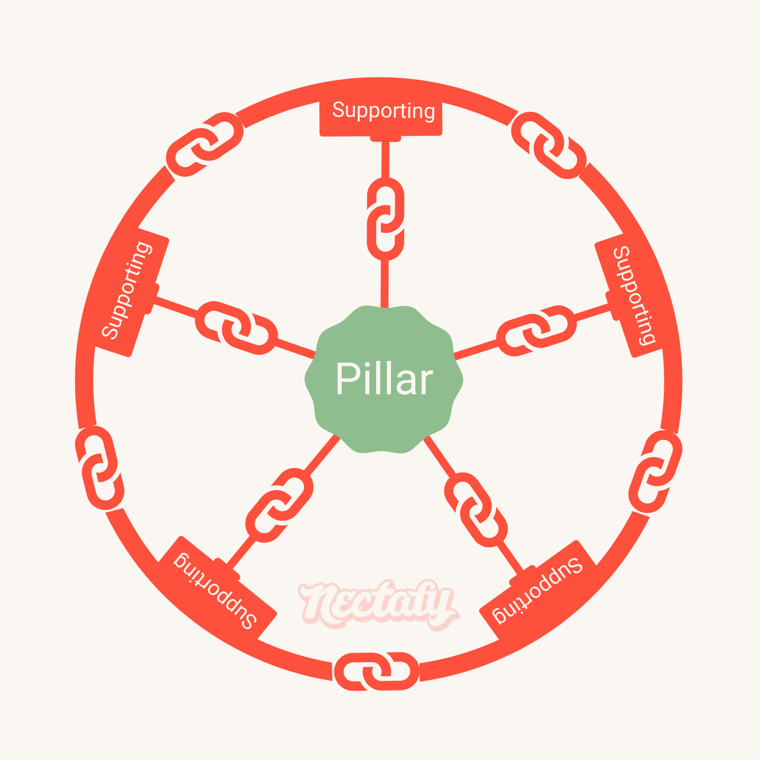SEO For Startups: 11 Tactics That Actually Work For New Websites



If you’re reading this article, three things are probably true:
- Your website is new.
- You’ve researched search engine optimization (SEO) and tried your hand at creating helpful content.
- You’re still stuck on pages 5-10 in search results.
You’re not the only one in this position—SEO for startups is anything but easy. You don’t have the benefit of having an established website with high domain authority, a score developed by Moz that predicts how likely you are to rank in search engine results. Essentially, the higher your domain authority, the more trust Google has in your website.
Below are some SEO tips for startups. In our experience, these are proven tactics that will help you build trust with not only Google, but also your target audience.
11 Ways To Supercharge SEO For Startups
1. Write Long-Form Articles
When you write thousands of words around one topic in a single article, Google sees that it’s a valuable resource. A long-form article is generally defined as anything over 2,000 words, and these longer pieces of content are most likely to appear higher in search results. As you can see in the chart below, it’s content between 2,000-2,450 words that usually gets in the first and second positions of search results.
To create your own long-form article, do some research and find a related bundle of keyword phrases that are below 0.5 in Google’s competition index. Competition for keywords and keyword phrases is calculated on a scale of 0-1 (with “0” meaning there is no competition and “1” meaning there is a lot of competition). Using keywords and phrases that are below 0.5 mean that you are more likely to rank for them.
Also, be sure the keywords and phrases you choose are things your buyer personas would actually search for. Once you have some direction, write as much helpful insight as you can around that one topic—the more words, the better.
See Also: How To Use SEMrush For Keyword Research: 18 Strategies To Pursue
As you prepare this article, you’ll probably come across a number of “subtopics” that you’ll want to write about in the post. Just make sure you do keyword research for these subtopics, too. While there should be one main keyword you’re going after, including supporting keywords in various sections of the article will help increase your rank for those keywords, too!
Recently, we wrote a 19,000-word article targeting a number of inbound marketing keywords. We've also worked on some client articles (coming in around 7,000 words) like this one about strategy implementation. In the 19,000-word Nectafy article, we shared much of what we know about inbound (as an inbound marketing agency), and we also strategically targeted a number of relevant keyword phrases. In doing this, we’ve noticed two crucial trends in our rankings.
First, we’ve seen some of our other pages increase in their authority around inbound keywords as a result of this article:
- “inbound marketing services”: from position 32 to 8 (here’s the page).
- “inbound marketing consultant”: from position 38 to 4 (here’s the article).
Second, many of the specific keywords we targeted with this article have jumped onto the first page of search results (but it has taken time):
- “inbound marketing plan”: from outside of the top 100 results to position 4.
- “inbound marketing strategy template”: from outside of the top 100 results to position 5.
2. Use Comparison Keywords
In any industry, people compare one thing to another. For example:
- Software A vs. Software B
- Company C vs. Company D
- Product X vs. Product Y
While it may seem strange, these are actually great keywords to target because they have a very low competition according to Google—meaning not many people are bidding on paid ads or are trying to rank organically for them.
In order to use this SEO tactic, think through some things your buyer persona may be comparing—software, competitors, products, events, blogs and publications, people and thought leaders, technology, categories, frameworks, ideas, and concepts. (That’s just a list to get you started!)
We’ve tried this tactic over the last year for one of our clients and have seen amazing results. Between November 2014 and March 2015, we published five comparison posts. Here are the incredible results these posts have brought:
- These five posts have received a combined 15,000 visits.
- We’ve collected over 150 new leads directly from these articles.
For even more details, be sure to check out this article on SEO strategy, including step-by-step instructions for finding comparison keywords you can try to rank for.
3. Do “Guestographics”
Backlinko’s Brian Dean coined this phrase (at least, we’re pretty certain he did).
The idea behind “guestographics” is sharing an infographic you created in an intentional, strategic way. There are five steps to the process:
- Create a great infographic that will be valuable and helpful to many people and post it to your site.
- Find other reputable websites that write about the infographic’s topic.
- Email those websites asking if they want to see your infographic.
- Give them the link and offer to write a brief guest post on the infographic.
- Should they accept your offer, you’ll receive a backlink with each published guest post!
Brian used this tactic with his own on-page SEO infographic. After sharing it, here are the results he saw:
- A huge increase in referring domains for that particular page.
- A 175.59% increase in organic search traffic to that page as compared to the previous month.
- The rank is now in the second or third position in search results for the keyword phrase “on-page SEO.”
Brian gives a lot more detail around each step, so be sure to check out his article, How To Get Backlinks With Guestographics, for further instruction!
4. Write About Key Performance Indicators
If you’re a B2B company, it’s highly likely that your buyer personas have key performance indicators (KPIs) they aim to reach.
Nearly every industry and company has certain quotas they try to meet that show they’re being successful, so it’s super valuable to target any KPI keyword phrases you can.
To give you an idea of how successful this can be, check out the results we’ve seen for one of our clients:
- They rank at position one or two in search results for 10 “kpi”-related keyword phrases.
- They rank at position one or two in search results for seven “key performance indicator”-related keyword phrases.
- They are currently ranking as the second search result for the keyword phrase “kpi example,” with a search volume of 5,400 searches each month and a mere .21 competition score!
While the search volume for these phrases is considered low to Google AdWords or HubSpot’s Keyword reporting, all the traffic that does search for these phrases is highly likely to consider our client’s page among the results. Another reason to give this tactic a try is because there’s virtually no competition for KPI-related keywords (as seen by our client’s crazy low competition score).
5. Employ internal linking.
Imagine two families—one has members who all eat dinner in their respective rooms while the other has members who dine together at the table, sharing stories about their day. Which scenario makes you feel all warm and fuzzy inside? Chances are it’s the latter example.
Google likes feeling the same way. In an SEO context, that means bringing together your blog posts (family members) by linking them so they can share their respective authority (stories). When Google crawls your website and sees Blog X linked to Blogs Y and Z, it gets the warm fuzzies, resulting in strengthened keyword rankings for all linked blogs.
SEO translation: We call these concepts link juice, where authority from one post is shared with the post it’s linked to, and keyword clustering, where you develop an interlinking or web of internal links to boost rankings throughout your website.
“Without internal linking, even the best blog posts may have limited authority, especially on newer websites,” says Matt Kenny, our lead content strategist here at Nectafy, “Your keyword rankings may max out at page two instead of being able to nab a coveted page one spot.”
Generally, you should aim to link to at least two related blog posts on your website for every post you publish; however, the relation doesn’t have to be direct, such as a project management post being linked to another project management post. You may have written a communication post that makes sense to link to from your project management post, as these concepts are highly correlated.
It doesn’t end there. Make sure you go back to older posts and link to newer ones, keeping in mind the relevance factor. Again, this signals to Google that you have a depth of knowledge around certain subject matter since you produce content that authoritatively covers related topics from multiple perspectives and angles.
6. Write pillar posts.
If you want to build authority around a certain topic, whether it’s content marketing or robotic process automation, write a pillar post. This type of post is essentially a lengthy piece—easily four times (or more) longer than most of the posts you write—that defines and describes a topic, breaking it down into clear, easy-to-understand sections. Each section could briefly address a different aspect of the topic, and then be covered in more depth in a separate post.
What do you do then? After reading the preceding tactic, you can probably guess: Link the pillar or parent post to the directly related child posts. Essentially, you’re being more purposeful and specific about internal linking.
The beauty of this approach is that the pillar post has a higher chance of ranking given how much coverage you have on the topic, and you then pass off the earned authority to each linked page. And thanks to the power of keyword clustering, the entire website stands to gain authority for the targeted subject matter.
7. Try guest posts.
Guest posts are content pieces you write that are published on another site (not yours). The point of guest posting is to not only reach a wider audience, but also to score a backlink—where the publishing site links back to yours.
Much like with internal linking, you should be guest posting about topics you would typically write about on your own site and preferably on websites related to your own. For example, if you’re a law firm that focuses on cases pertaining to intellectual property, it wouldn’t make sense for you to be guest posting on a retail furniture blog. However, it would be sensible to guest post on a legal software blog.
When your guest post is linked back to your website, Google views this as a vote of confidence, whether for relevance or domain authority. Yes, domain authority may come into play in some cases, such as when you have the opportunity to guest post on a highly regarded site like Forbes. Though it’s generally better to focus on relevance than domain authority.
Keep in mind that you should look at guest posting as trying to genuinely help your target audience—and close-fitting personas—with your insights on a topic. Don’t fall into the trap of content collusion, or working with another company for the sole purpose of link swapping. Google actually frowns upon this behavior.
8. Create video content.
Adding video to blog posts, especially lengthier ones, can positively impact your rank. Video content accomplishes a few things:
- It gives the audience a different—and some would say more convenient—way to consume information.
- It improves the accessibility of your site, which Google likes.
- It adds more context around the topic (assuming you don’t simply read the post verbatim), so the audience can better grasp the concepts.
- It often increases the time visitors spend on a page, which has a positive correlation with ranking.

The length of time visitors spend on your site matters. The search engine wants to present users with the most relevant information based on their search queries; if users are frequently exiting a page shortly after clicking on it, Google may start considering that page as irrelevant or misaligned with user intent. That means your rankings could go down.
Therefore, resist the urge to create a video that simply parrots back the article to the user. Instead, provide additional context and a unique learning experience. Try summarizing the article in a brief three- to four-minute video, walking through the main points.
“Creating a video for some of your blog posts doesn’t have to be a lot of work,” says Kenny. “You don’t want it to look thrown together, but you’re also not producing a network TV show. And it can be as formal or informal as you want—just make sure it’s on-brand, like everything else you share.”
9. Produce FAQ content.
FAQ content is something else you can add to a blog post. While not a different medium, it does offer a distinct way for an audience to consume information. For example, some audience members may have a solid grasp of the topic, but are confused about certain aspects of the subject matter. They may appreciate getting to the point regarding a specific question they want answered.
An FAQ section is also useful for Google. Kenny says it’s a great way to help your content rank. “We’ve seen multiple ranking improvements using this tactic—even without making any other changes.”
Why does this tactic work? You’ve undoubtedly noticed the “People also ask…” widget on Google searches. This widget includes questions people commonly search on Google that are related to your search terms. For example, you may use search terms such as SEO for tech startups or SEO for SaaS startups and find questions like these in the widget:
- Do startups need SEO?
- How do I do SEO for SaaS?
- What is SEO in a startup?
- How do you do SaaS content marketing?
- What is the best SEO strategy for 2021?
You can build out an FAQ section by looking at the topic you’re addressing and seeing what questions are being asked about it on Google. Address these real questions and insert clear, relevant answers. This will help showcase your authority and make it easier for users to find the answers they need—your answers may even show up in the “People also ask…” widget, increasing your exposure.
10. Use long-tail keywords.
If you’re trying to build authority on a certain topic, you can’t just target keywords that are competitive and have a high search volume. You must first start with less competitive keywords—these are typically long-tail keywords or keyword phrases that have context or specificity.
For example, digital marketing is a highly competitive keyword, so you might want to start with a long-tail keyword such as digital marketing for B2B companies or digital marketing examples for SaaS companies.
You can use Google’s keyword planner or a similar tool to see keyword stats and what users are searching for related to a keyword. Look for keywords with lower volume or competitiveness so you’re not competing with higher authority sites like Wikipedia. Then create content using the long-tail keywords you identify.
Monitor your blog for positive traction—for example, getting multiple page-one rankings with several posts in the top three spots in conjunction with increased traffic. This could be a signal for you to consider targeting more competitive keywords.
“Remember to take your time as you transition into keywords with greater competition,” says Kenny. “You may think your blog is ready to take on the challenge, but you may find your rankings falling short of expectations. Monitor and adjust your strategy until you reach success.”
11. Remove value-less pages from your website.
We saved this tactic for last because it may not be applicable for all newer companies, especially ones that haven’t even started their blogs yet.
If you’re well into your content marketing efforts, you may have produced numerous blog posts—but not all of them are ranking and providing value to your site. For these posts, it can sometimes be useful to redirect or remove them from your site entirely. Here are two key types of pages to look out for:
- Cannibal pages. These pages have content that overlaps with one or more other blog posts; as such, they are all competing to rank for the same keywords. Called keyword cannibalization, this phenomenon ultimately drags down the rankings of all competing pages.
- Zombie pages. If you have pages that aren’t generating value—they have low traffic, inconsistent viewership, etc.—then they’re considered zombie pages. Zombies are typically bad in any context, whether in horror films or on blogs. In this context, it’s because Google has a crawl budget that essentially limits how many pages it’s willing to review on your site. That means every page needs to have value; otherwise, you risk Google passing up pages that have a better chance of ranking.
For cannibal pages, try combining the content of the competing posts into a single post —and use the URL of the one with the better ranking. Then do a permanent redirect of the other posts to the chosen URL. “This way, any residual SEO value of the competing posts is passed to the remaining post,” Kenny explains.
For zombie pages, or any page that doesn’t have content that can’t be used in other posts, then find a proper way to remove the post altogether since it has little to no SEO value to pass on.
An Expert’s Note About SEO For Startups
While the above SEO tips for startups will come in handy as you get your content marketing off the ground, there’s one important thing to understand:
SEO doesn’t have a rule book.
“SEO is part science, part art, and a little bit of luck that all depends on your ability to consistently produce high-quality, strategy-supported content focused on your target audience’s needs—not a search engine’s,” Kenny explains. “You should keep Google in mind, but your audience needs to come first—just as they do for creating your products and delivering your services.”
Moving Beyond SEO For New Websites
While the above tactics can help you earn Google’s trust for a new website, there are other aspects to consider that can aid in keeping your site optimized for search engines and improve its overall health. Here are a few good reads to keep you informed and your efforts on track:
- Search Engine Optimization (SEO) Starter Guide
- The Importance Of Content Strategy & How To Get Started [Images + Data]
- Writing A Blog For Your Business: 7 Key Tips
- How Much Can You Increase Organic Traffic In 12 Months? [CALCULATOR]
- 22 SEO Myths & Misconceptions
If you made it to the end of this post, you’re now keenly aware of the complex nature of SEO for startups (or any company for that matter). All the tips in the world can’t replace an expert team that does content marketing for a living.
But we’re more than just an SEO agency for startups. We handle strategy, content production, execution, monitoring, and reporting—every aspect of growth marketing that contributes to your business success. We’d love to show you the magic of this highly effective marketing initiative—drop us a line if you’d like to talk.



